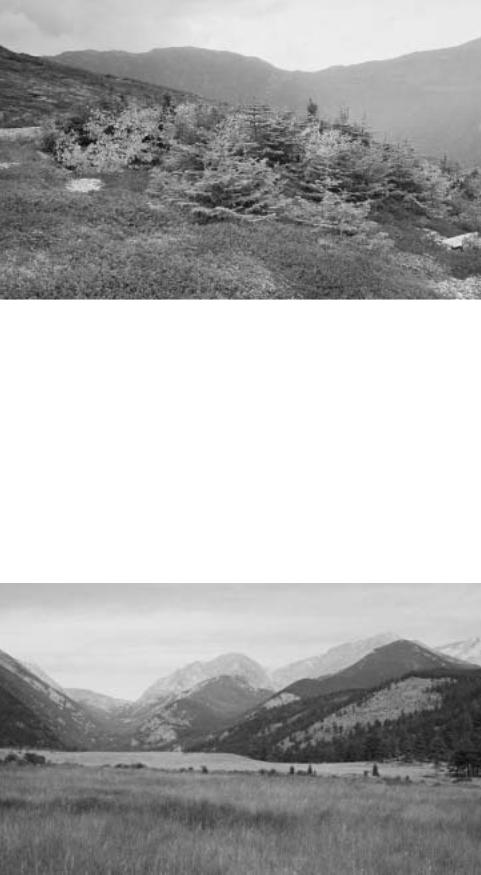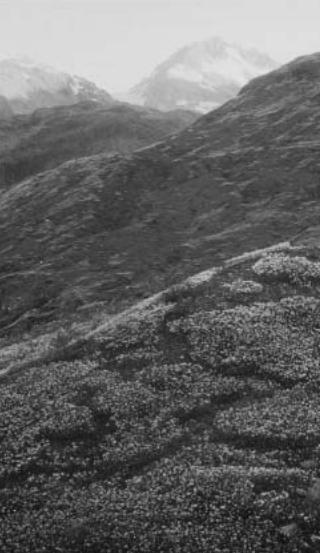

PAGE PROOF: 2ND PASS
Alpine and Arctic Vegetation
Grassland and Shrubland
Alpine shrublands extend upward from tree line on high mountains, and are often interspersed with alpine grasslands (Figure 19.21). The vegetation in these areas can include both what we typically think of as shrubs— multi-stemmed woody plants of short stature—and bizarre-looking plants that have a rosette form that can grow 3–5 m tall (see Figure 6.12). Alpine shrublands are found on all of the continents except Australia and Antarctica. In South America, they constitute a large part of the high-altitude vegetation type called paramo. Heath is the name for a general vegetation type that is
Biomes 399
Figure 19.21
Alpine shrubland on Mt. Washington in the state of New Hampshire. (Photograph ©
M. P. Gadomski/Photo Researchers, Inc.)
dominated by low-growing ericaceous shrubs, and in some parts of the world alpine shrublands consist to a large extent of heath vegetation. In the northern temperate zone, the shrubs are typically Salix (willow) and Betula (birch).
Above tree line in mountainous areas or in areas with cold air drainage, alpine grasslands are the major community type (Figure 19.22). These grasslands are often dominated by sedges, plants in the family Cyperaceae that are closely related to and similar in growth form to grasses. These communities can also contain scattered shrubs, dwarf trees, and small, herbaceous perennial plants that are shaped like little cushions, thus grading into alpine shrublands and tundra.
Figure 19.22
Alpine grassland in Rocky Mountain National Park, Colorado. (Photograph by S. Scheiner.)
400 Chapter 19
Temperate and tropical alpine areas differ in some important ways. Temperate alpine regions have long, cold winters, during which the ground is frozen and deep snow covers much of the vegetation for long periods. Snowmelt generally marks the start of spring growth. In contrast, tropical alpine regions, especially in very high mountains, have a strong daily temperature cycle, as if it were winter every night and summer every afternoon. Growth continues year-round, and the soil does not freeze (at least not deeply or for long periods of time). All alpine regions have very high solar energy input because the atmosphere is thinner than at sea level, so there is less to filter (i.e., absorb and scatter) incoming sunlight. The sunlight is particularly intense in tropical alpine regions because the angle of incoming solar radiation is most direct over the Tropics. The resulting high levels of ultraviolet radiation can damage biochemical processes in leaves (and can cause severe sunburn in humans).
The total area occupied by alpine vegetation of all types is low. Precipitation is generally limited in these areas, and productivity and species diversity are also low. The harsh climate, steep slopes, and low productivity of alpine regions have combined to keep human population sizes low from prehistory to the present, although several distinct cultures, such as those of the Incan and Tibetan peoples, have developed and thrived in high mountain regions. Even small human populations, however, can still have significant effects on alpine habitats. The cold temperatures mean than many processes, such as plant growth, soil formation, and decomposition, are very slow. As a result, human activities such as mining and grazing (the primary form of agriculture in these regions) can have very long-lasting effects.
Tundra
Tundra is found in areas where temperatures are too cold for tree growth. There are vast areas of arctic tundra in northern North America and Eurasia. Because there is little land in the Southern Hemisphere at high latitudes, there is little tundra there—only a few areas on the Antarctic Peninsula and neighboring islands are referred to as tundra. Conditions at the tops of high mountains, including wind and extreme cold, create alpine tundra.
The arctic tundra has long, dark, and often bitterly cold winters and short, cool summers with up to 24 hours of sunlight. The soil thaws each summer to a depth of only 25–30 cm, resulting in permafrost, a permanently frozen layer of soil, which severely limits root growth. Trees are excluded from the arctic tundra by a combination of factors, including permafrost and extreme cold. Temperatures below 40°C kill almost all living aboveground plant tissue, preventing long-lived plants such as trees from becoming established. Another factor lim-
PAGE PROOF: 2ND PASS
iting tree growth is that emergent vegetation above the snow cover in winter would experience not only extreme cold, but also high winds, especially in alpine areas. Tundra soils are generally young and poorly differentiated (often inceptisols; see Table 4.1) because most arctic tundra sites were glaciated in the recent past. Litter decomposition is generally slow due to the cold temperatures and consequently low microbial activity and, secondarily, the anaerobic conditions in many places.
Alpine and arctic tundra have similarities and differences. Both have short growing seasons, and alpine tundra (at least in temperate areas, although not in the Tropics) is subject to severe cold in winter. In both types of tundra, most precipitation is in the form of snow, so that there are long periods during which plants are unable to take up moisture; in many settings (such as the alpine tundra at mid-latitudes in western North America), drought is common during the summer. Arctic and alpine tundra differ greatly in other factors, including day length, atmospheric pressures, partial pressures of gasses such as CO2, exposure to ultraviolet radiation, and soil conditions.
Many genera and species found in Northern Hemisphere alpine tundra are also found in the arctic tundra. Oxyria digyna (mountain sorrel, Polygonaceae) is a plant found both in the Arctic and in alpine areas of the western and eastern United States and Europe. A comparative study of arctic and alpine populations of this plant concluded that they are each adapted to specific local conditions. Compared with the arctic plants, the alpine plants had a lower leaf chlorophyll content, a higher respiratory rate, and a lower light saturation point. Alpine tundra species are often evolved from local lowland species. In the high Andes, for example, there are many species of high-altitude bromeliads, a group we normally associate with tropical forests.
The growth forms of tundra plants include low shrubs, taller shrubs alongside rivers, herbaceous perennials, grasses and sedges, mosses, and lichens. Different plant communities exist within the tundra, depending on topography, soils, and other factors. Tussock tundra is dominated by grasses and sedges (notably by the sedge Eriophorum vaginatum), deciduous shrubs, and evergreen shrubs in roughly equal abundance. Riparian bottomlands are dominated by relatively tall (1–4 m) willows and other shrubs. Wet sedge tundra, dominated by low-statured (< 20–30 cm) rhizomatous sedges, covers flat areas with restricted drainage, forming a broad expanse on the Arctic coastal plain of Alaska as well as in other areas. Soils typically thaw to only 25–30 cm here, and the freeze-thaw cycle often creates a characteristic ice wedge-shaped pattern in the soil. The soils of wet sedge tundra have very high organic matter content and may be covered with water during the summer because the frozen soil prevents drainage.

PAGE PROOF: 2ND PASS
Biomes 401
Plant species diversity in the tundra is very low. Many genera (such as Salix) and even some species (e.g.,
Dryas octopetala, Eriophorum vaginatum, and Oxyria digyna) are common across the circumpolar Arctic (Figure 19.23), and similar communities are found over wide ranges. Animal population densities and species richness are also low. However, the Arctic provides critical habitat both for species that are characteristic of this region, such as lemmings, and for others, such as wolves, that have been reduced to low numbers elsewhere. Brown bears, grizzly bears, polar bears, snowshoe hare, lynx, moose, and caribou (called reindeer in northern Europe) are some of the other large mammals
Figure 19.23
The vegetation of this Arctic tundra along Glacier Bay in southern Alaska is dominated by species of Dryas (Rosaceae). (Photograph courtesy of L. Walker.)
that are notable components of the arctic fauna, and marine species such as walrus and various seal and whale species are native to, or rely heavily on, arctic habitats. The arctic tundra serves as critical nesting area for many bird species, particularly those associated with wetlands.
Human population sizes and densities in the tundra are extremely low (under 1 person/km2), although humans have lived in, traveled through, and exploited arctic environments since prehistoric times. In spite of these low population sizes, humans have managed to pollute arctic environments in disproportion to our numbers, and the cold temperatures mean that the pollution persists for a long time. Small soil disturbances can last a very long time. In the arctic tundra, disturbance may result in the melting of permafrost, which leads to subsidence and soil compaction. Perhaps the most threatening of all ecological effects is human-caused global warming, which is predicted to be greatest in polar regions (see Chapter 22).
Summary
Biomes are large regions that differ from one another in the structure of their vegetation. They are strongly determined by climate—temperature, rainfall, and sea- sonality—and, to a lesser extent, by soil properties. While the boundaries of biomes are defined arbitrarily, the concept of the biome remains a useful one so long as it is clear that it is a descriptive categorization. There is a broad consensus among scientists on the classification of biomes.
Biomes are classified based on whether they are dominated by trees (forests and woodlands), shrubs, or grasses and other herbaceous species. Forests are further classified by whether the trees are evergreen or deciduous, broad-leaved or needle-leaved. Where conditions become too dry for trees, grasses predominate; grasslands can be tropical, temperate, alpine, or arctic. Shrubs dominate under a variety of conditions, including those that are too hot or dry for grasses, those with very seasonal precipitation, in some very cold regions, or as a secondary result of overgrazing or fire suppression.
All biomes are heavily affected by humans. Some, such as temperate deciduous forests, can recover relatively rapidly from human disturbance because many of their species disperse readily and grow rapidly. Others, such as hot deserts, recover poorly because their plants disperse poorly and grow slowly. Full recovery in still others, such as tropical forests, is difficult because of soil destruction and species extinctions in these highly diverse communities. Recovery of all damaged or degraded biomes is limited by continued encroachment, habitat destruction, and global climate change.

402 Chapter 19
Additional Readings
Classic References
Braun, E. L. 1950. Deciduous Forests of Eastern North America. Blakiston,
Philadelphia, PA.
Rübel, E. 1936. Plant communities of the world. In Essays in Geobotany in Honor of William Albert Setchel, T. H. Goodspeed (ed.), 263–290. University of California Press, Berkeley, CA.
Schimper, A. F. W. 1903. Plant-Geography upon a Physiological Basis. Clarendon Press, Oxford.
Tansley, A. G. 1939. The British Islands and Their Vegetation. Cambridge University Press, Cambridge.
Contemporary Research
Brais, S., C. Camire, Y. Bergeron and D. Pare. 1995. Changes in nutrient availability and forest floor characteristics in relation to stand age and forest composition in the southern part of the boreal forest of northwestern Quebec. Forest Ecol. Mgmt. 76: 181–189.
PAGE PROOF: 2ND PASS
Pastor, J., Y. Cohen and R. Moen. 1999. Generation of spatial patterns in boreal forest landscapes. Ecosystems 2: 439–450.
Pitman, N. C. A., J. Terborgh, M. R. Silman and P. Nuñez V. 1999. Tree species distribution in an upper Amazonian forest. Ecology 80: 1651–1661.
Additional Resources
Bowden, C. 1993. The Secret Forest. University of New Mexico Press, Albuquerque.
Brown, J. H. and M. V. Lomolino. 1998. Biogeography. 2nd ed. Sinauer Associates, Sunderland, MA.
Davis, M. B. 1996. Eastern Old-Growth Forests. Island Press, Washington,
DC.
Reisner, M. 1993. Cadillac Desert: The American West and Its Disappearing Water. Penguin Books, New York.
